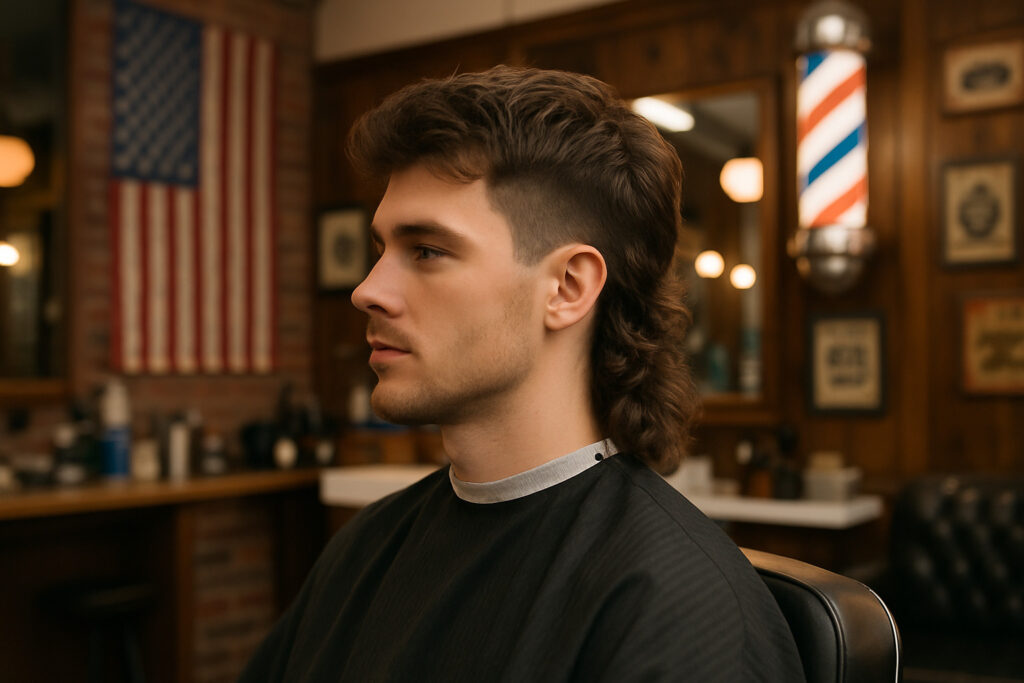The Mullet Haircut Makes Its Bold Comeback
The mullet haircut is having a major moment. This iconic “business in the front, party in the back” style has evolved from 1980s rock star territory into one of 2024’s most requested cuts.
Quick Mullet Facts:
- Definition: Short hair on top and sides, longer hair in back
- Modern twist: Softer layers, fades, and textured styling
- Best for: Oval, square, and heart-shaped faces
- Maintenance: Trim every 4-6 weeks
- Cost: Starting around $30 at most barbershops
What started as an ancient warrior hairstyle got its name from the Beastie Boys’ 1994 song “Mullet Head.” The style peaked in the ’80s with icons like David Bowie and Joan Jett, then mostly disappeared until recently.
The pandemic changed everything. When salons closed in 2020, people started experimenting at home. Gen Z and younger millennials acceptd the cut as a form of self-expression and rebellion against traditional beauty standards.
Today’s mullets are way more wearable than their predecessors. Modern versions feature subtle fades, textured layers, and styling that works for professional settings. The USA Mullet Championships launched in 2020, and a Tennessee woman holds the Guinness World Record for the longest competitive mullet at 68 inches.
Whether you’re considering a subtle modern mullet or going full retro, this guide covers everything you need to know about making this trend work for your lifestyle.
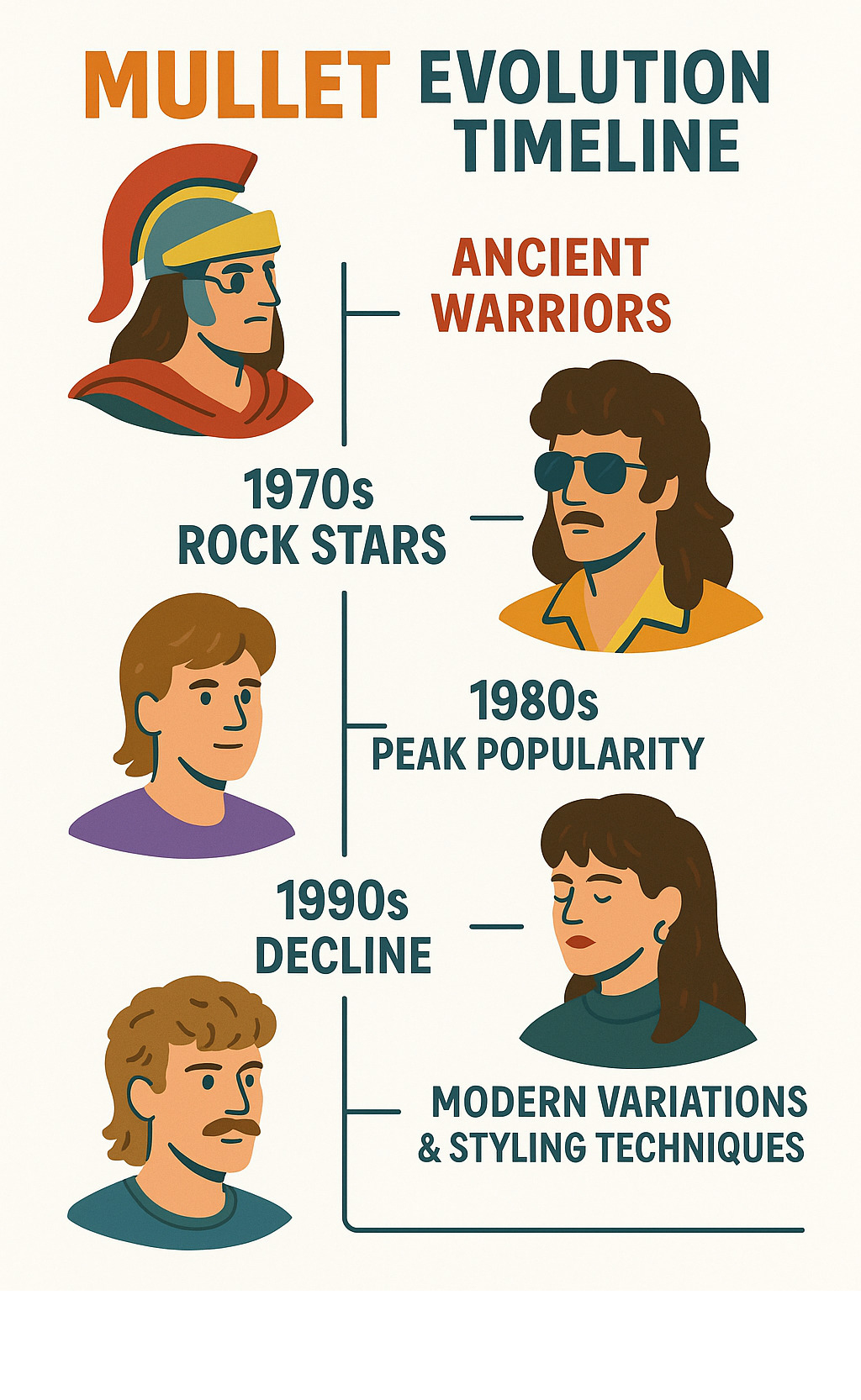
Key mullet haircut vocabulary:
What Is a Mullet Haircut?
Picture this: you’re looking at someone from the front, and they appear to have a neat, professional haircut. Walk around to the back, and suddenly there’s flowing hair that tells a completely different story. That’s the magic of a mullet haircut – it’s literally two hairstyles in one.
The classic “business in the front, party in the back” description perfectly captures how this cut works. The front, top, and sides stay shorter (usually 2-4 inches), while the back flows longer. Modern versions use techniques like taper fades and textured layering to create smoother, more wearable transitions.
Scientific research on ancient mullets shows that similar styles existed thousands of years ago. Ancient Greek warriors called the Abantes wore their hair short in front and long in back – partly for practical reasons and partly for aerodynamics in battle.
Mullet Haircut Definition & Etymology
The mullet haircut hasn’t always been called a mullet. The Historical definition of “mullet” from the Oxford English Dictionary shows the hairstyle usage only dates back to the mid-1990s.
We can thank the Beastie Boys for giving this cut its official name. Mike D coined “Mullet Head” in their 1994 song, and it stuck. Before that, people called it “the hockey haircut,” “the Missouri Compromise,” or “Mississippi Mud Flap.”
What’s fascinating is how this style appeared across different cultures throughout history. Native American tribes, ancient Romans, and various European groups all developed versions of short-front, long-back arrangements independently.
Mullet Haircut Through the Decades
The 1960s and 1970s saw the birth of the modern mullet during the counterculture movement. David Bowie started experimenting with asymmetrical cuts that challenged everything people thought they knew about “proper” hair.
The 1980s were the mullet’s golden age. Rock stars, athletes, and actors made it mainstream cool. Joan Jett’s fierce version became punk rock royalty, while TV shows like Miami Vice brought it into living rooms everywhere.
The 1990s and 2000s saw the mullet fall out of fashion as grunge and minimalist styles took over. Pop culture began mocking it, and it quickly became associated with outdated fashion.
But 2020 changed everything. When COVID-19 lockdowns closed salons, people got creative with DIY cuts. The mullet emerged as a symbol of pandemic-era experimentation. The USA Mullet Championships launched that same year, and in 2023, Tami Manis from Tennessee set the Guinness World Record for the longest competitive mullet at 172.72 cm (68.00 inches).
Types & Modern Variations of the Mullet
The mullet haircut has evolved far beyond its one-size-fits-all origins. Today’s versions offer something for everyone, whether you’re looking for subtle professional vibes or full-on rock star energy.
The classic mullet stays true to its roots with that unmistakable short-to-long contrast. The modern mullet softens those harsh lines with gentle layering throughout, creating a more workplace-friendly option.
The wolf cut blend has become incredibly popular, especially among younger generations. This style mixes the wolf cut‘s shaggy, textured layers with classic mullet proportions, creating tons of movement and dimension.
The shag mullet uses choppy, layered cutting techniques throughout for that deliberately messy, rock-and-roll vibe. The burst fade mullet brings the cut into the modern barbershop era with curved fade techniques around your ears.
For those wanting to make a serious statement, there’s the skullet – completely shaved on top with long hair in back. Curly-haired folks can work with their natural texture, while the Asian two-block variation features distinctly disconnected layers popularized by K-pop culture.
The peso pluma style adds Latin flair with specific layering techniques that create incredible texture and movement.
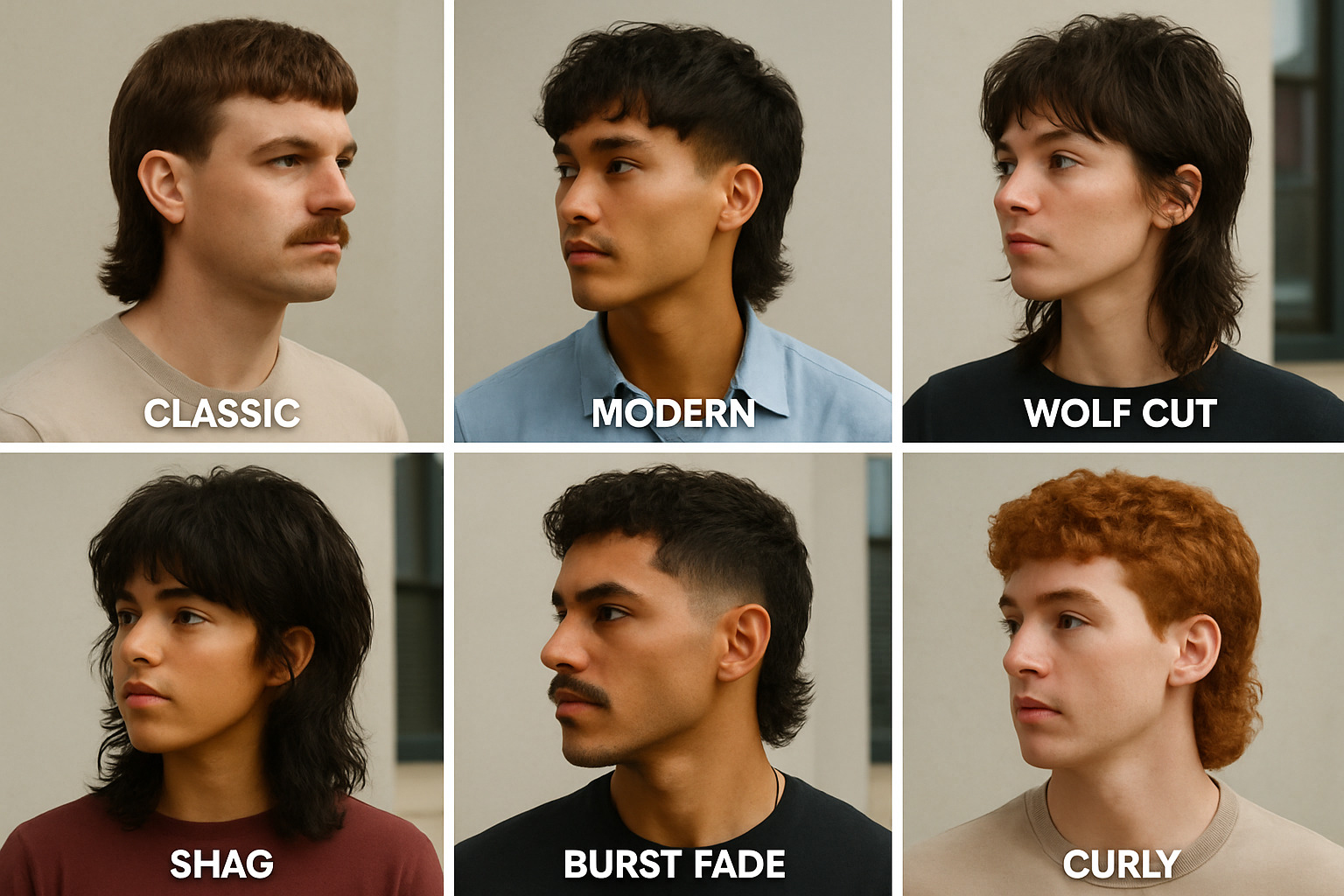
Trendiest Mullet Styles for 2025
The mullet haircut scene is constantly evolving, and 2025 is bringing exciting new twists.
The short taper mullet is perfect for commitment-phobes, keeping the back relatively short while incorporating a clean taper fade. Mohawk mullets combine two rebellious styles by buzzing the sides while the center strip flows into that longer back section.
Taking inspiration from the trending butterfly haircut, the butterfly-influenced mullet adds gorgeous face-framing layers. The undercut mullet creates dramatic contrast with sharp undercuts, while color-blocked mullets use strategic coloring to emphasize the cut’s natural structure.
Face Shapes & Hair Textures That Rock a Mullet
There’s probably a mullet haircut variation that works for your face shape and hair type.
Oval faces can handle almost any mullet style. Square faces benefit from softer layered versions that avoid emphasizing angular jawlines. Heart-shaped faces benefit from mullets that add width at the jawline, while round faces should focus on styles that add height on top.
Straight hair gives you the most versatility but might need extra styling products. Wavy hair is practically made for shag and wolf cut mullets. Curly hair requires gentle handling and moisture-rich products, while coarse hair benefits from thinning techniques to prevent bulk.
How to Get, Grow & Style Your Own Mullet
So you’ve decided to get a mullet haircut? Let’s talk strategy.
Starting from scratch requires patience. You’ll need at least 3-4 inches of hair all around to create a proper mullet foundation. Scientific research on hair growth shows our hair grows about half an inch per month, so plan for 6-8 months to go from super short to mullet-ready length.
During this growing phase, regular trims every 6-8 weeks will keep things looking intentional. Your first mullet deserves professional hands. The proportions and angles that make a mullet look cool require genuine skill. A good barber will assess your face shape, hair texture, and lifestyle.
The cutting process involves sectioning your hair into distinct zones – front, top, sides, and back. The back section gets the most attention, often using point-cutting techniques for natural texture. Maintenance is non-negotiable – plan for trims every 4-6 weeks.
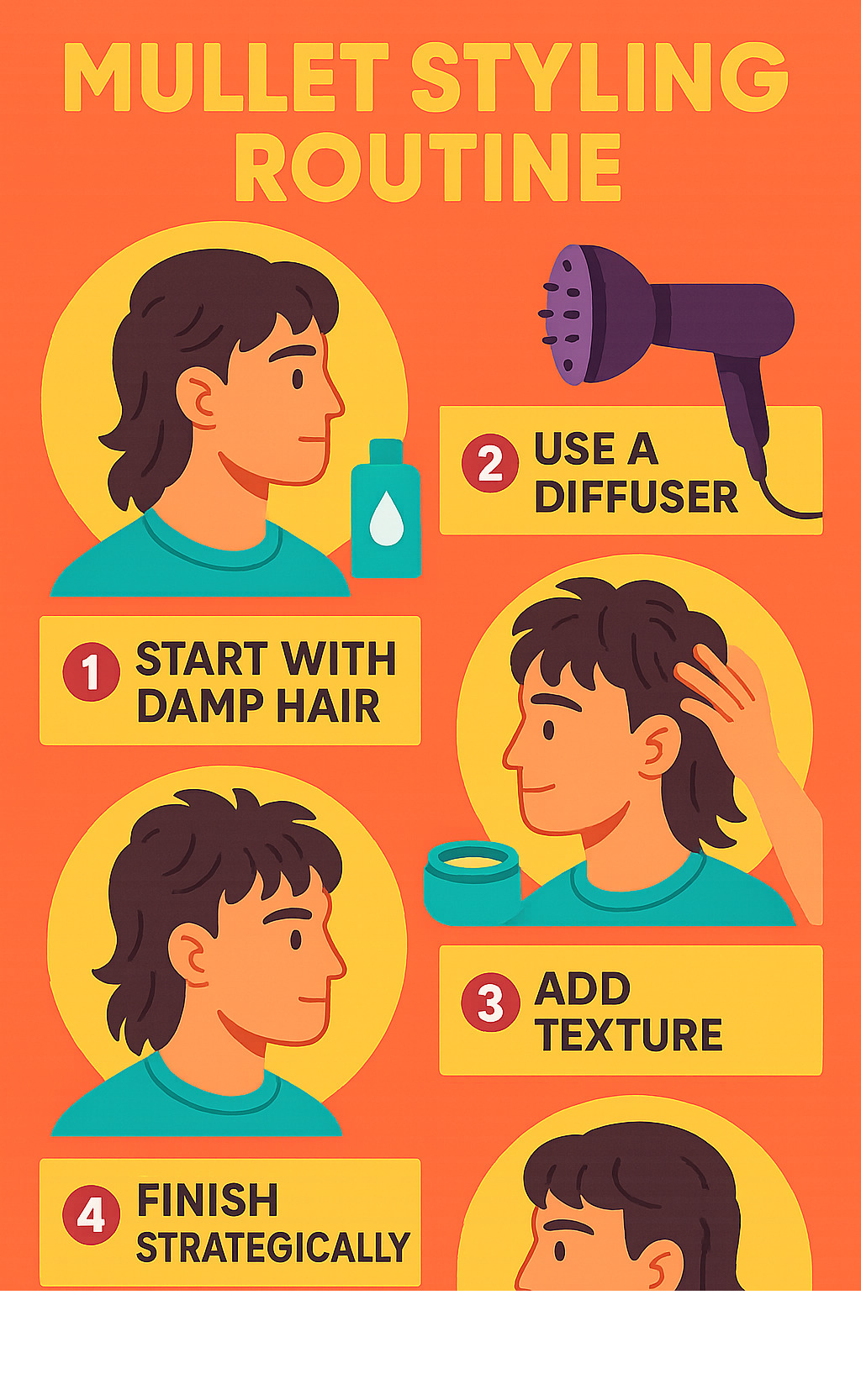
Pro Styling Tips & Product Routine
Mullets can look effortlessly cool or completely chaotic – the difference usually comes down to styling technique.
Start with damp hair and apply volumizing mousse or sea salt spray from roots to ends. Texture is your best friend. Work a small amount of matte clay or texturizing powder through the mid-lengths and ends, focusing on creating separation rather than slicking everything down.
Strategic finishing makes all the difference. Use a tiny bit of pomade on just the front section if you need control for work situations. Leave the back section more natural and touchable.
For products, we recommend chemical-free hair products that won’t build up over time. Volumizing shampoo should only be used 2-3 times per week, while sea salt spray adds texture without stiffness.
Pro styling secrets: Skip daily washing – mullets look better with some natural oils. Use dry shampoo to refresh between washes. Scrunch the back section while damp to improve natural texture. Sleep on a silk pillowcase to prevent frizz.
Pros & Cons of the Mullet
Let’s be honest about what you’re signing up for with a mullet haircut.
The upside is compelling. A mullet makes an undeniable personal statement and offers versatility – you can style the front sleek for professional settings while keeping the back relaxed. It’s definitely a conversation starter and connects you to music and cultural history.
But there are challenges. Some workplaces still aren’t mullet-friendly. The maintenance is real – you’ll need regular trims and daily styling. Social reactions can be intense, and growing out a mullet involves awkward phases. Weather becomes your enemy, and you’ll become dependent on styling products.
The bottom line? Mullets work best for people who enjoy expressing individuality and don’t mind standing out. If you’re ready to make a statement and commit to maintenance, a modern mullet can be incredibly fun and flattering.
Cultural Impact & Famous Mullet Moments
The mullet haircut has woven itself into popular culture in ways that go far beyond simple hairstyle trends. From music stages to sports arenas, this distinctive cut has served as a symbol of rebellion, authenticity, and self-expression.
David Bowie pioneered the artistic potential of the mullet in the early 1970s, changing it from a practical haircut into a statement of creative freedom. Joan Jett’s fierce mullet became as iconic as her music, representing a rejection of traditional feminine beauty standards.
Sports culture, particularly hockey, created memorable mullet moments. The “hockey hair” phenomenon turned the mullet haircut into a badge of athletic toughness. Mike Gundy, the Oklahoma State football coach, famously claimed his mullet generated millions in marketing value.
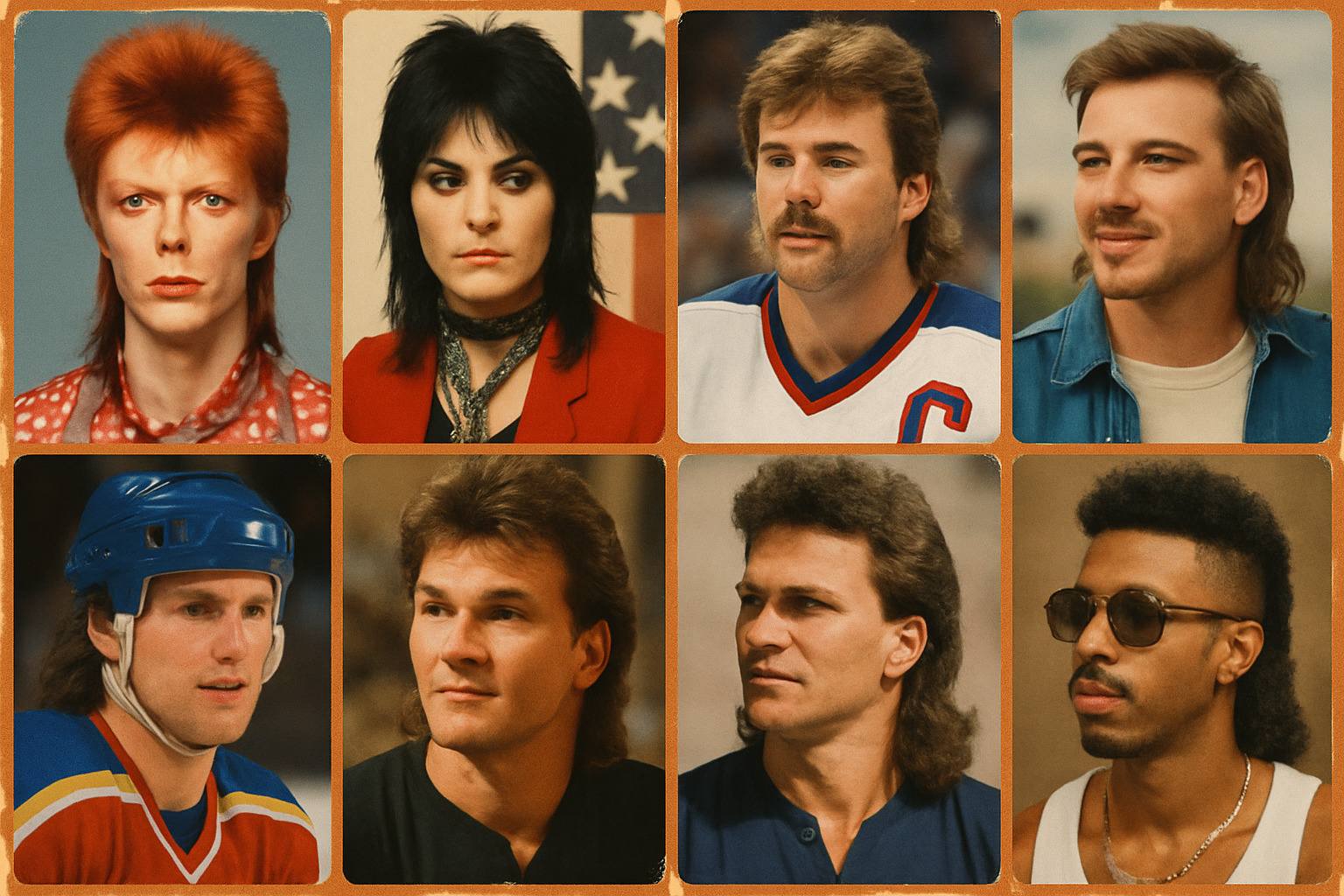
The mullet’s cultural significance extends into important identity movements. In 1980s lesbian culture, the style served as both practical choice and powerful symbol of gender nonconformity. Australia’s “bogan” subculture adopted mullets as part of their proud working-class identity.
The political power of the mullet haircut becomes clear when we look at international reactions. Iran once banned mullets as a “decadent Western cut,” recognizing that hairstyles can carry political messages.
Kiefer Sutherland helped cement the mullet’s place in 1980s pop culture through “The Lost Boys,” while Peso Pluma made it his signature look after accidentally receiving one during a visit to Medellín.
The ultimate dedication might be represented by Tami Manis, the Guinness World Record holder for the longest competitive mullet at 68 inches, grown over 33 years.
Today’s mullet renaissance reflects broader cultural shifts toward authenticity and individual expression. The mullet haircut has evolved from a symbol of rebellion to one of creative self-expression, proving that sometimes the most mocked trends can become the most enduring.
Frequently Asked Questions About the Mullet
Why did the mullet become popular?
The mullet haircut became popular for surprisingly practical reasons at first. Ancient warriors finded it offered real battlefield advantages – the short front kept hair out of their eyes during combat, while the longer back protected their necks from sun and weapons. Pretty smart, right?
Fast forward to modern times, and the mullet’s appeal became more about attitude than armor. The style exploded in the 1970s and 1980s because it perfectly captured the era’s rebellious spirit. Rock stars and athletes wore mullets to show they didn’t follow conventional rules about appearance.
What made the mullet genius was its dual personality. You could look professional and put-together from the front – perfect for job interviews or meeting parents. But turn around, and that flowing back section announced your creative, free-spirited side. It was like having a secret identity built into your haircut.
The recent comeback happened for different reasons entirely. When COVID-19 locked down salons in 2020, people got creative with DIY cuts. The mullet haircut emerged as a symbol of pandemic-era experimentation and making the best of unusual circumstances. Gen Z and millennials acceptd it as vintage-cool rather than outdated, proving that every generation refinds rebellion in their own way.
What hair type suits a mullet best?
Here’s the great news – almost any hair type can rock a mullet haircut with the right approach. It’s more about finding the variation that works with your natural texture than fighting against it.
Wavy hair is probably the most naturally suited for mullets. The texture adds movement and prevents the style from looking too harsh or structured. If you have waves, consider yourself lucky – shag and wolf cut variations will look effortlessly cool on you.
Straight hair can absolutely work, but you’ll need to put in a bit more styling effort. The key is using texturizing products to prevent limpness and add some grip to your hair. Modern mullets with proper layering help create the movement that straight hair sometimes lacks naturally.
Curly hair creates stunning mullets when cut by someone who understands curl patterns. The secret is working with your natural texture instead of trying to tame it. Avoid over-layering, which can create unwanted bulk, and invest in moisture-rich products to keep your curls healthy and defined.
Thick hair benefits from strategic thinning techniques, especially in the back section where weight can accumulate. A skilled stylist will remove bulk while maintaining the mullet’s signature shape. Fine hair works best with shorter, more subtle mullet variations that won’t look stringy or overwhelmed by extreme length differences.
The most important factor isn’t your hair type – it’s finding a stylist who knows how to adapt the mullet haircut to your specific hair characteristics and lifestyle.
How has the mullet’s reputation changed since the 1980s?
The mullet’s reputation has been on quite the rollercoaster ride. Back in the 1980s, wearing a mullet haircut meant you were genuinely cool. Rock stars, movie actors, and professional athletes sported mullets with pride. It was the height of fashion and represented creativity and rebellion against boring, conventional styles.
Then came the backlash. During the 1990s and 2000s, the mullet became comedy gold – and not in a good way. TV shows and movies used mullets as visual shorthand for characters who were out of touch, unsophisticated, or stuck in the past. The style became so stigmatized that admitting you once had a mullet was almost embarrassing.
The 2020s changed everything. Today’s mullet revival has completely rehabilitated its reputation. Modern celebrities and social media influencers wear updated versions that look intentional and fashion-forward rather than accidental or dated. The key difference is that contemporary mullets are often more subtle and incorporate current styling techniques.
Now the mullet haircut is seen as vintage-cool rather than outdated. Some people wear it with intentional irony, while others accept it as authentic self-expression. The improved cutting and styling techniques mean today’s mullets integrate better with professional wardrobes and contemporary aesthetics.
Workplace acceptance still varies significantly though. Creative industries and companies with younger demographics tend to be more accepting. Traditional corporate environments might still raise eyebrows, so consider your professional context before making the leap. The good news is that attitudes continue shifting toward greater acceptance of individual expression in professional settings.
Conclusion
The mullet haircut has come a long way from its humble beginnings as ancient warrior practicality. Today, it stands as one of the most exciting examples of how classic styles can reinvent themselves for new generations.
What’s remarkable about the current mullet revival is how it reflects our changing attitudes toward self-expression and authenticity. The modern mullet haircut offers something for almost everyone, whether you’re drawn to a subtle taper mullet for corporate settings or want to go bold with a color-blocked variation.
The best mullet is one that makes you feel like yourself. Work with a stylist who understands both the technical aspects and cultural significance of what you’re choosing. The maintenance aspect can’t be overlooked – those 4-6 week trim cycles and daily styling routines are part of the commitment.
At Beyond Beauty Lab, we believe your beauty choices should support your overall wellness and authentic self-expression. The mullet, when chosen thoughtfully and maintained properly, can be both a confidence booster and a form of creative self-care.
The mullet haircut has survived decades of changing trends because it represents something deeper than fashion – it’s about having the courage to stand out and express yourself boldly. Whether you’re ready to take the plunge or just mullet-curious, the most important thing is choosing a style that makes you feel genuinely confident and authentic.
After all, the best hairstyle isn’t the one that looks perfect in magazines – it’s the one that makes you smile when you catch your reflection.

